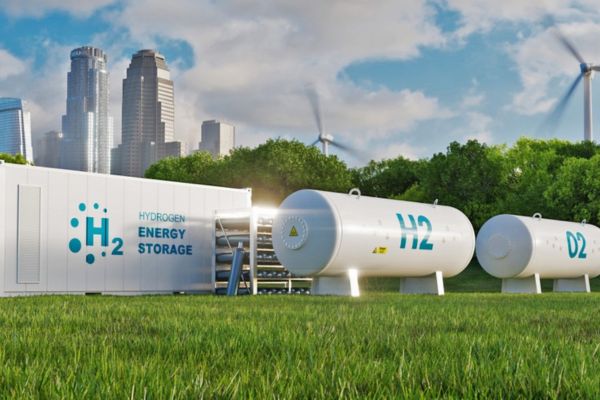Hydrogen energy storage is a process wherein the surplus of energy created by renewables during low energy demand periods is used to power electrolysis, a process in which an electrical current is passed through a chemical solution in order to separate hydrogen. Once hydrogen is created through electrolysis it can be used in stationary fuel cells, for power generation, to provide fuel for fuel cell vehicles, injected into natural gas pipelines to reduce their carbon intensity, or even stored as a compressed gas, cryogenic liquid or wide variety of loosely-bonded hydride compounds for later use. Hydrogen created through electrolysis is showing great promise as an economic fuel choice, with data from the International Energy Agency predicting that hydrogen generated from wind will be cheaper than natural gas by 2031.

Drivers of Hydrogen Energy Storage Market Growth
- Renewable Energy Integration: One of the primary drivers of the hydrogen energy storage market is the increasing integration of renewable energy sources like wind and solar power into the grid. These sources are inherently intermittent, and hydrogen storage offers a solution to store excess energy during peak production periods for use during times of low generation.
- Energy Transition Initiatives: Governments and industry players worldwide are investing in clean energy technologies to mitigate climate change and reduce greenhouse gas emissions. Hydrogen, particularly when produced using renewable energy sources through electrolysis, aligns with these objectives, driving investments in hydrogen energy storage infrastructure.
- Industrial Applications: Hydrogen is widely used in industrial processes such as refining, ammonia production, and metal processing. Utilizing hydrogen energy storage systems allows industries to manage energy demand fluctuations efficiently and enhance overall energy security.
- Transportation Sector: The transportation sector is undergoing a paradigm shift towards zero-emission vehicles. Hydrogen fuel cell vehicles (FCVs) present a viable alternative to conventional internal combustion engines, offering longer ranges and shorter refueling times. Hydrogen energy storage facilitates the scaling up of hydrogen refueling infrastructure to support the widespread adoption of FCVs.
Challenges and Barriers
Despite its potential, the widespread adoption of hydrogen energy storage faces several challenges:
- Cost: The cost of hydrogen production, storage, and distribution remains relatively high compared to conventional fossil fuels. While advancements in electrolysis and other hydrogen production technologies are driving costs down, further innovation and economies of scale are necessary to make hydrogen energy storage economically competitive.
- Infrastructure Development: Establishing a comprehensive hydrogen infrastructure, including production facilities, storage tanks, pipelines, and refueling stations, requires substantial investments. Building this infrastructure will take time and coordination among stakeholders, presenting a barrier to rapid market expansion.
- Technological Maturity: While hydrogen energy storage technologies have made significant strides, they are still relatively nascent compared to conventional energy storage solutions like lithium-ion batteries. Enhancements in hydrogen storage materials, system efficiency, and reliability are needed to accelerate market adoption.
- Regulatory Frameworks: The lack of consistent regulatory frameworks and incentives for hydrogen energy storage hinders market development. Governments play a crucial role in providing supportive policies, subsidies, and incentives to spur investment in hydrogen infrastructure and stimulate demand for hydrogen-based products and services.
Future Outlook
Despite the challenges, the future outlook for the hydrogen energy storage market is promising:
- Technological Advancements: Continued research and development efforts are driving technological innovations in hydrogen production, storage, and utilization. Advancements in electrolysis, hydrogen compression, and fuel cell technologies are expected to improve efficiency and reduce costs, making hydrogen energy storage more competitive.
- Policy Support: Governments worldwide are increasingly recognizing the role of hydrogen in achieving climate goals and promoting energy security. Policy measures such as carbon pricing, renewable energy mandates, and investment incentives for hydrogen infrastructure are expected to bolster market growth.
- Industry Collaboration: Collaboration among governments, industry players, research institutions, and other stakeholders is essential for advancing the hydrogen energy storage ecosystem. Public-private partnerships and international cooperation initiatives can facilitate knowledge sharing, resource mobilization, and technology transfer, driving innovation and market expansion.
- Market Expansion: As economies of scale are achieved and production costs decline, hydrogen energy storage solutions are likely to become more widespread across various sectors. From grid-scale storage applications to transportation and industrial uses, hydrogen is poised to play a significant role in the global energy landscape.















